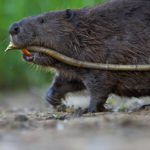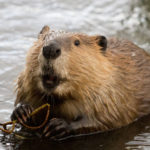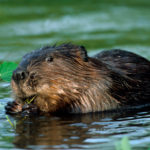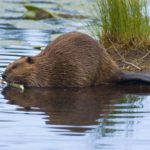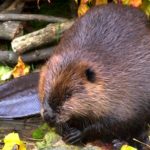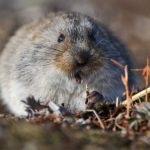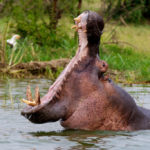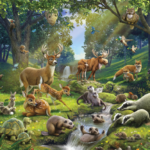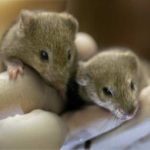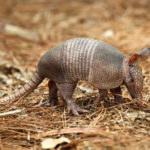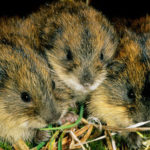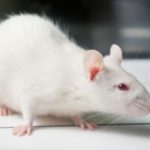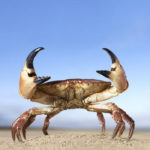Beavers – information
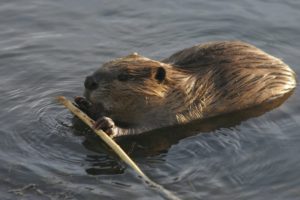 Beavers are famous for their unsurpassed engineering abilities, these are the only animals that actively change the environment and adapt it to their needs, even highly developed monkeys do not know how to equip their habitat! First of all beavers build complex dwellings. The type of dwelling depends on habitat conditions. If the banks of the river are formed by dense ground, slightly elevated (1-2 m) and steep, then the beavers dig on the shore of the burrow. For security purposes, the hole exit is located under the water, from it deep into the shore there is a move that ends with a living chamber. In this cell there can be several rooms-rooms: there are places for a parent couple and young animals, as well as a special latrine.
Beavers are famous for their unsurpassed engineering abilities, these are the only animals that actively change the environment and adapt it to their needs, even highly developed monkeys do not know how to equip their habitat! First of all beavers build complex dwellings. The type of dwelling depends on habitat conditions. If the banks of the river are formed by dense ground, slightly elevated (1-2 m) and steep, then the beavers dig on the shore of the burrow. For security purposes, the hole exit is located under the water, from it deep into the shore there is a move that ends with a living chamber. In this cell there can be several rooms-rooms: there are places for a parent couple and young animals, as well as a special latrine.
If the banks of the reservoir are shallow, marshy, the soil is viscous, then the beavers build a dwelling right in the middle of the pond. To do this, they apply soil (mostly clay) to the center of the reservoir, from above, several large logs are placed on this “foundation”, and walls and a roof of small branches are built on their basis. Apparently, when building beavers, they use the same engineering plan as humans. Such a structure is called a hut, it rises above the water’s edge, in this elevated part of the hut there is a living chamber. Its internal structure is similar to that in the burrow, the height of the hut can reach 10 m, width 15 m, but the above-water part has a height of only 1-3 m.
But by the construction of housing alone, the abilities of beavers are not limited. These animals actively create themselves the most comfortable and comfortable conditions of existence. The main problem for beavers is the land predators, it is precisely for protection from them that beavers build their complex dwellings. But even burrows and huts do not save them from the summer shallowing of the reservoir and the need to go ashore in search of food. To protect themselves from all troubles, beavers break through the feed canals, which from the river lead deep into the forest, so beavers do not have to go overland.
By general belief, beavers eat wood, but this is not entirely true. Large and thick trunks of beavers do not actually eat, but they are used only for construction needs, but young and thin branches of trees and shrubs to the beavers to taste. In the summer, beavers gnaw small branches often directly with greens, in addition they often eat juicy and green parts of aquatic plants (rhizomes and greens of egg-caps, water lilies, cattails, etc.). Since there are not so many branches in accessible reach, the beavers are forced to cut down large trees to reach the inexhaustible pantry – the crown. Beavers do not eat all trees, prefer hardwoods with softwood (willow, aspen, birch, poplar, linden, hazel). Also, beavers avoid unnecessary labor costs – do not bring down trees with hard and solid wood (oaks, beeches, etc.).
Depending on the thickness of the trunk, the beaver can drop a tree from 2 minutes (an aspen thickness of up to 5 cm) to a day (a tree 25-40 cm thick), and over large trees, beavers often work together. Beavers gnaw the tree in a circle, sitting on its hind legs and leaning on its tail. At the same time, they leave a characteristic cone-like stump, sometimes such hemps reach a height of 1-2 m (this means the beavers knocked the tree in winter, when the snow cover was high). There are known cases of death of beavers from trees that fell on them. In general, beavers prefer to harvest forage in summer and autumn, in winter their “lesopovalnye” instincts are much weaker.
Beavers are monogamous animals, they form pairs that last for life. Only a widowed animal can form a pair with a new partner. It is interesting that the beavers are matriarchy, the head of the family is the female. The marriage period for beavers comes early – in January-February. Since these animals remain faithful to their partner, they have no complex marriage rituals. Pregnancy lasts 105-107 days. The female gives birth in April-May in the nesting chamber 2-5 (usually 3) cubs.
The beaver cubs, unlike most rodents, are born sighted and covered with fur; already 1-2 days after birth, they can swim, and after 3 weeks they start eating on their own. Despite such precocity, the young live for a long time next to their parents in the same dwelling and leave them not earlier than the next spring (and often only after 2-3 years). This is due to the complex ways of extracting food and building, which requires a lot of time to master. These animals reach sexual maturity by the age of 3, but live in natural conditions for 10-15 years, in captivity up to 35 years.
Large size does not save beavers from predators, because the sheer awkwardness of these animals on land makes them relatively easy and attractive prey. Wolves, coyotes, bears are hunting for beavers, less often lynxes.
